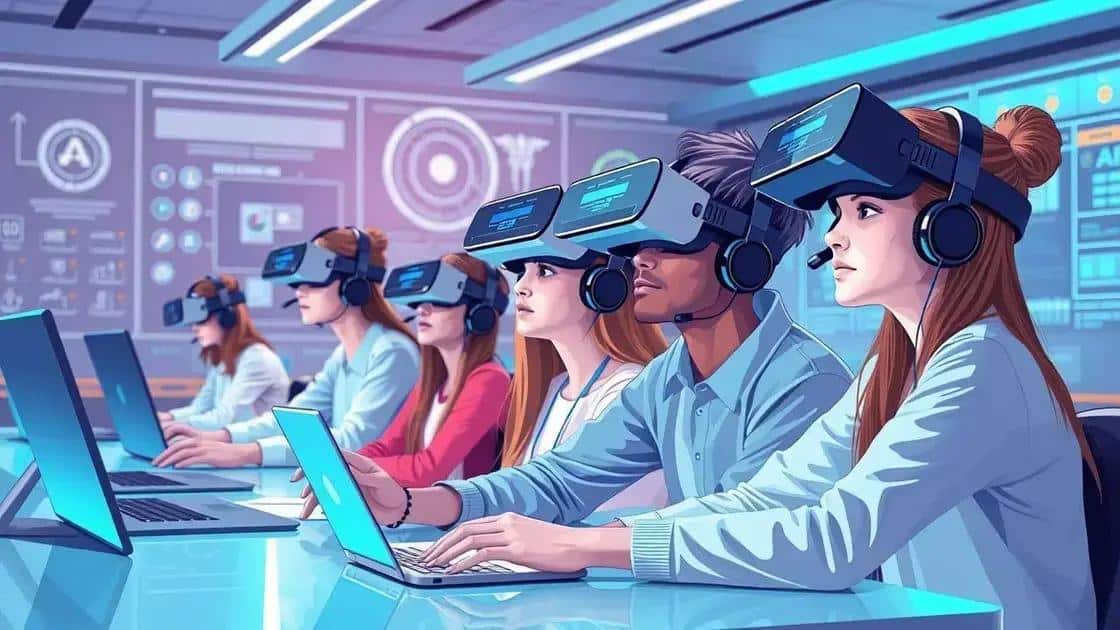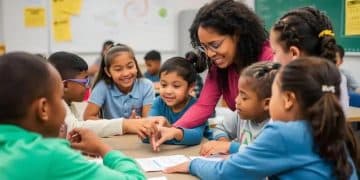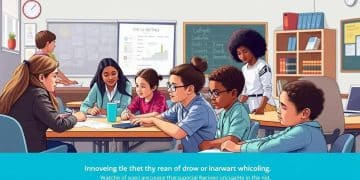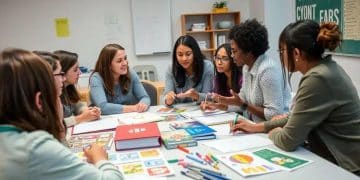Digital classrooms transforming education for the better

Anúncios
Digital classrooms integrate technology to enhance learning experiences by improving student engagement, offering personalized education, and facilitating collaboration among peers, while also presenting challenges like accessibility and the need for teacher training.
Digital classrooms are changing how students and teachers interact, breaking down barriers to learning. Ever wondered how these new environments can enhance education? Let’s dive into the impact they have on our schools.
Anúncios
Understanding digital classrooms
Understanding digital classrooms is essential in today’s educational landscape. These innovative learning environments use technology to enhance student engagement and improve the learning experience.
What are digital classrooms?
Digital classrooms integrate traditional teaching methods with modern technology. They bring together various digital tools that support learning processes. This approach makes education more interactive and accessible.
Key Features of Digital Classrooms
- Real-time collaboration tools that allow students to work together, regardless of location.
- Access to a wealth of resources online, including videos, articles, and e-books.
- Flexibility in learning styles, accommodating different preferences.
- Instant feedback through quizzes and assessments.
By utilizing these features, educators can create a more personalized learning experience. Students are often more motivated in digital classrooms because they can learn at their own pace. This environment fosters independence and encourages exploration.
Anúncios
The benefits extend beyond student engagement. Teachers can streamline administrative tasks with digital platforms, allowing them to focus on teaching. They can track progress with analytics tools, making it easier to address individual student needs.
Additionally, digital classrooms promote an inclusive atmosphere. Students with disabilities can access specific resources tailored to their requirements. This approach levels the playing field, ensuring all learners have the opportunity to succeed.
As technology continues to evolve, so will digital classrooms. Keeping up with the latest developments is crucial for teachers and students alike. Embracing innovations can lead to exciting changes in educational practices.
Benefits of digital classrooms

The benefits of digital classrooms are transforming the educational landscape. By incorporating technology into learning, schools can create an engaging atmosphere that enhances student participation.
Improved Engagement
Students in digital classrooms often feel more involved with their lessons. Interactive tools and resources keep their attention better than traditional methods. This boost in engagement encourages participation and a genuine interest in learning.
Flexible Learning Environments
One major advantage is the flexibility offered by digital classrooms. Students can access materials anytime and anywhere. This freedom allows them to learn at their own pace, accommodating different learning styles.
- Ability to review lectures and materials multiple times.
- Online discussions can continue beyond classroom hours.
- Personalized learning experiences tailored to individual needs.
Moreover, digital classrooms facilitate collaboration through various online tools. Students can work together on projects, share resources, and communicate seamlessly. This collaboration helps them build essential social skills while enhancing their learning experience.
Another important benefit is access to diverse resources. Educational apps, videos, and articles are just a click away. This variety not only makes learning more enjoyable but also enriches the curriculum.
Cost-effectiveness is another aspect that cannot be overlooked. With digital classrooms, schools can reduce expenses related to printing and materials. Moreover, many digital resources are available for free or at a lower cost compared to traditional textbooks.
In essence, the benefits of digital classrooms extend well beyond just technology. They create an enriched educational experience that prepares students for a better future, fostering essential skills in a rapidly changing world.
Challenges in implementing digital classrooms
While digital classrooms offer many benefits, there are also significant challenges in their implementation. Understanding these challenges is crucial for educators and administrators aiming for success.
Technological Barriers
One of the primary obstacles is the technology itself. Not all students may have access to devices or stable internet connections. This digital divide can create inequalities in learning opportunities.
Training and Support
Educators need proper training to use new technologies effectively. Without adequate support, teachers may feel overwhelmed or unsure of how to integrate digital tools into their lessons.
- Professional development sessions are essential for boosting teacher confidence.
- Ongoing technical support helps resolve issues quickly.
- Collaboration among educators fosters a community of learning.
Moreover, resistance to change can hinder progress. Some educators may prefer traditional teaching methods, fearing that technology will complicate their teaching process rather than enhance it. Overcoming this mindset requires a strong commitment from school leaders to promote a culture of innovation.
Another challenge is maintaining student attention in a digital environment. With distractions readily available online, keeping students engaged can be difficult. Strategies to capture interest, such as interactive content and gamified learning, are essential in these classrooms.
Additionally, privacy and security concerns emerge with the use of digital platforms. Schools must ensure that student data is protected and that ethical guidelines are followed. This responsibility requires ongoing attention and compliance with regulations.
Implementing digital classrooms is not without its struggles. However, addressing these challenges head-on can lead to a more effective and inclusive learning environment. By understanding and mitigating these obstacles, schools can pave the way for a rich educational experience.
Future trends in digital classrooms

The future trends in digital classrooms are shaping the next generation of education. As technology evolves, schools are adapting to these changes to enhance learning experiences.
Personalized Learning
One significant trend is the move towards personalized learning. Using data and analytics, educators can tailor lessons to meet individual student needs. This approach allows students to learn at their own pace and according to their interests.
Artificial Intelligence Integration
Artificial intelligence (AI) is also playing a crucial role in digital classrooms. AI tools can assist teachers in grading assignments and providing feedback. This technology helps to streamline administrative tasks, allowing educators to focus more on teaching and less on paperwork.
- AI can analyze student performance and suggest resources aligned with their learning styles.
- Chatbots offer immediate support for student inquiries outside classroom hours.
- Adaptive learning platforms adjust materials based on student progress.
Additionally, immersive technologies like virtual reality (VR) and augmented reality (AR) are becoming more prevalent. These tools enable students to explore new environments and concepts interactively. For example, history students can take virtual field trips to ancient civilizations, bringing lessons to life.
Another trend is the collaboration and engagement that social media tools foster. Classrooms are increasingly integrating platforms that allow students to connect with peers and experts worldwide. This global classroom environment enriches students’ perspectives and experiences.
As schools continue to adopt blended learning models, both in-person and online teaching will become commonplace. Facilitators are enhancing traditional methods with digital tools, creating a more balanced approach to education.
The future trends in digital classrooms signify a shift towards more engaging and flexible learning environments. By embracing these trends, educators can prepare students for a future where technology plays a central role in their learning journeys.
In summary, digital classrooms are revolutionizing education by offering various benefits, such as personalized learning and increased engagement. Although there are challenges in implementing these technologies, the positive impact on student experiences and outcomes cannot be overlooked. By embracing future trends like AI and immersive technologies, educators can create dynamic learning environments that prepare students for success in a rapidly changing world. As we move forward, it is essential to adapt and innovate, ensuring that every student has access to the tools they need to thrive.
FAQ – Frequently Asked Questions about Digital Classrooms
What are digital classrooms?
Digital classrooms use technology to enhance teaching and learning, allowing for interactive and flexible education experiences.
What are some benefits of digital classrooms?
Benefits include improved student engagement, access to diverse resources, and personalized learning opportunities.
What challenges do schools face in implementing digital classrooms?
Challenges include technological barriers, the need for teacher training, and resistance to change among staff.
How is technology shaping the future of education?
Technology is driving trends like personalized learning, AI integration, and immersive learning experiences in classrooms.






